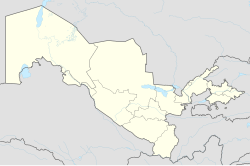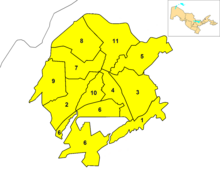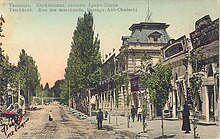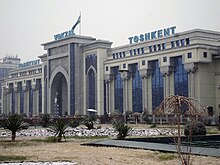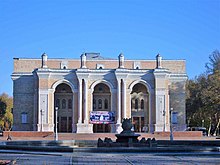Tashkent
| Tashkent | ||
|
usb. : Toshkent (Тошкент) |
||
|
City arms |
||
| Basic data | ||
|---|---|---|
| State : |
|
|
| City with provincial rank: | Tashkent | |
| Coordinates : | 41 ° 20 ′ N , 69 ° 18 ′ E | |
|
|
||
| Height : | 455 m | |
| Area : | 334.8 km² | |
| Residents : | 2,371,300 (2015) | |
| Agglomeration : | 2,644,400 (2015) | |
| Telephone code : | (+998) 71 | |
| Postal code : | 100000-100214 | |
| License plate : | 01-09 | |
| Structure and administration (status: 2018) | ||
| Mayor : | Jahongir Ortiqxoʻjayev | |
| Website : | ||
Tashkent ( Uzbek Toshkent , stone city , formerly Cyrillic. Тошкент; Russian Ташкент Tashkent ) is the capital of Uzbekistan . The city, with a population of more than two million, is located north of the Great Silk Road on the border with Kazakhstan on the western edge of the Tian Shan . Tashkent is the capital of the Tashkent province of the same name , but is not part of it itself, but is administered as an independent city at provincial level.
It is an industrial city (energy industry, machine and aircraft construction, cotton processing, food industry), a traffic junction with the subway and airport and a cultural center with universities , colleges, research institutes, theaters, museums, observatory and zoo. A modern landmark of Tashkent is the television tower .
Surname
The old name of the city was "Tschatsch" (Persian Čāč or Čāğ ) - Arabicized "Schāsch" ( Šāš ) - and is u. a. mentioned in Sassanid inscriptions and in Shāhnāma Firdausi ; its etymology is not clear. Among other things, an attempt was made to connect the word with a Yenisei word for "stone". So the name could be traced back to the time of the Hunnic occupation of Sogdia ; However, since it can already be proven under Shapur I (240–272), this attempted explanation appears to be wrong. The earliest Chinese sources also transcribe the name of the city with the symbol shih , meaning “stone”. A possible Tocharian origin is also discussed.
The modern name of the city, in the Perso-Arabic script asتاشکند/ “Tāškand” transcribed, is composed of “Tasch” and the Sogdian word for city (“kand”). It can be detected in the Tāriḫ al-Hind of al-Biruni at the earliest , on coins only in the Mongolian epoch . "Tasch" can u. a. borrowed from the Turkish word for stone ("taş") and thus a translation of earlier names. This would give the modern Uzbek meaning “city made of stones”. The orientalist D. Sinor, however, sees the Turkish word "Taz" as the origin of the word, which is itself a conversion of the Arabic tribal name Tayy . The Tayy were among the first Arab tribes in Central Asia, and in the course of time their name in the Turkish languages , first as "Taz" and later as "Tāt (sh)", applied to all Muslims and then specifically to the Islamicized and sedentary Iranian population of the region, who at the time made up the majority of Central Asia's population. Today it is included in the ethnonyms of the Iranian- speaking Tajiks and Tat . Thus, according to this definition, the meaning “city of the (Muslim) Iranians” would result. However, this derivation finds “hardly any approval”.
The current Tajik name is Toshkand (Тошканд). Other names of the city that are no longer used today are Schasch or Binkent .
geography
The urban area of Tashkent has an area of 334.8 square kilometers. This corresponds to a little more than a third of the area of Berlin. The city lies at an altitude of about 455 meters on the western foothills of the Tianshan Mountains. The Ankhor River flows through them; the river Chirchiq runs from the northeast on the southern city limits .
climate
The climate is very continental with hot, dry summers and cold winters. The mean annual temperature is around 13.5 ° C. In summer, temperatures rise to over 35 ° C, in winter temperatures are well below freezing point. The total annual rainfall is around 418.8 mm. Most precipitation falls from November to March.
| Tashkent | ||||||||||||||||||||||||||||||||||||||||||||||||
|---|---|---|---|---|---|---|---|---|---|---|---|---|---|---|---|---|---|---|---|---|---|---|---|---|---|---|---|---|---|---|---|---|---|---|---|---|---|---|---|---|---|---|---|---|---|---|---|---|
| Climate diagram | ||||||||||||||||||||||||||||||||||||||||||||||||
| ||||||||||||||||||||||||||||||||||||||||||||||||
|
Average monthly temperatures and rainfall for Tashkent
Source: WMO ; wetterkontor.de
|
|||||||||||||||||||||||||||||||||||||||||||||||||||||||||||||||||||||||||||||||||||||||||||||||||||||||||||||||||||||||||||||||||||||||||||||||||||||||||||||||||||||
City structure
| 1. Bektemir | 7. Shoyhontohur |
| 2. Chilonzor | 8. Sobir Rahimov |
| 3. Yashnobod | 9. Uch Tepa |
| 4. Mirobod | 10. Yakkasaroy |
| 5. Mirzo Ulug'bek | 11. Yunusobod |
| 6. Sirg'ali |
population
religion
Uzbeks (they make up the majority of the population in Tashkent) as well as the numerous minorities represented in the city such as Tatars, Tajiks and Uighurs traditionally profess Sunni Islam. There are therefore innumerable monuments of Islamic architecture in the city. Tashkent is also the seat of the Eparchen of the Russian Orthodox Church in Uzbekistan and the Bishop of the Evangelical Lutheran Church in Uzbekistan .
The main Catholic church in Tashkent, built in 1912, was misappropriated during the Soviet era. Since 1991 it has belonged again to the Catholic community of Tashkent, and it was consecrated again in 2000 after the restoration work. For this purpose the Catholic St. Paulus Congregation in Bonn donated an organ.
Due to the long membership in the Soviet Union, there is also a comparatively high number of non-denominational in Tashkent .
Population development according to the UN
The population of Tashkent exceeded the million mark for the first time in the 1960s and stood at 2.4 million in 2017. A further increase to 3 million inhabitants is expected by 2035.
| year | population |
|---|---|
| 1950 | 755,000 |
| 1960 | 964,000 |
| 1970 | 1,403,000 |
| 1980 | 1,818,000 |
| 1990 | 2,100,000 |
| 2000 | 2,135,000 |
| 2010 | 2,244,000 |
| 2017 | 2,435,000 |
history
Ancient and Middle Ages
Tashkent was founded in the 3rd century BC. First mentioned in Chinese sources.
In 751, Arab forces took Tashkent and hit the western outposts of the Chinese . This meant that Arab expansion had reached its limits for the time being. At the same time, Islam spread in the area . In the 9th and 10th centuries Tashkent fell to the Samanid state . During this time the two Islamic scholars al-Haitham ibn Kulaib asch-Shāschī (d. 946) and Abū Bakr al-Qaffāl asch-Shāschī (d. 976) worked here. Tashkent was first mentioned as a city in the 11th century.
In 1220 Genghis Khan conquered the city and incorporated it into his empire. In the 14th century, Tashkent regained wealth under the warrior Timur Lenk and the Timurids . Later on, Tashkent was disputed between Bukharian, Uzbek and Kazakh khanates.
In the 17th and 18th centuries, camel caravans brought goods to the north by land, especially from Tashkent. Especially under Tsar Peter I (1682–1725), diplomatic relations between Russia and the Central Asian khanates were strengthened . Legations were often exchanged.
Russian conquest
In 1839 the Russian Tsar Nicholas I tried to prevent the British from expanding into the area. In 1865 Tashkent was conquered by Russian forces and in 1867 it was made the center of the General Government of Turkestan .
Soviet time
After the October Revolution of 1917, Tashkent was declared the capital of the Autonomous Soviet Socialist Republic of Turkestan within Russia on April 18, 1918 . When the ASSR Turkestan was split up in 1924, Tashkent became the capital of the Uzbek SSR , which was newly founded on October 27, 1924 within the Soviet Union . However, the immediate northern hinterland of the city came to the Kazakh SSR , so that the city became a border town.
Tashkent as the center of Central Asian Islam
During the Soviet period, the city developed into an important center of Islamic activity. The most important representative of learned Islam in Tashkent after 1919 was Saʿīd ibn Muhammad al-ʿAsalī (d. 1932), known as Shami Damulla . His teaching activities led to the formation of a group known as the Ahl al-Hadith of Tashkent. But they had no relationship with the Ahl-i Hadith in India. When Shami Damullah was banished from Tashkent in 1932, his disciple Jamal-Khwaja-Ishan from the Chuqur-Qishlaq Mosque took over the management of the Ahl al-Hadith and held it until he was arrested and executed in 1937. After the arrest of Jamal-Khwaja-Ishan, the leadership of the Ahl al-Hadith Mulla Nafiq (Shah-Rasul), the imam of the Rakat Mosque in Tashkent, was transferred. A second group of Islamic activists were ascetics led by Sabircha-Damulla from Qaunchi village.
After the political circles around Stalin had decided in 1943 to improve the state's relationship with the religious communities, four muftiates were created who were to be responsible for the spiritual affairs of the Muslims of the Soviet Union. One of these muftiates was the Spiritual Administration of the Muslims of Central Asia and Kazakhstan (SADUM), founded in July 1943 and located in Tashkent. SADUM decided to open two madrasas , one with 30 students in Tashkent and the other with 60 students in Bukhara, a plan that was approved by the Soviet leadership in October 1945. The Baraq Khan Madrasa in Tashkent was only able to start work in 1956 and was closed again in 1961. To this end, the Islamic Institute Imam al-Buchari was founded in Tashkent in 1971 , and it still exists today. In addition to these official teaching centers, various illegal Islamic teaching circles were formed in Tashkent, which were called hujra and had different orientations ( Hanafi , Shafiite , Sufi ).
Labor camp
There were two Soviet labor camps ( gulags ) in the city . From 1930 to 1943 the Central Asian ITL existed here , a prison camp with at times over 36,000 internees. They performed forced labor in cotton production, in hydraulic engineering, in consumer goods production and in the transport of goods. From 1945 to 1946 the ANGREN-ITL existed with up to 1,700 inmates, most of whom had to work in open-cast coal mining as well as in industrial, road and housing construction. The prisoner of war camp 386 for German prisoners of war of the Second World War was also in Tashkent.
Urban development after the Second World War
In an earthquake on April 26, 1966 , significant parts of the city were destroyed. This gave the city planners the opportunity to implement their vision of a new city as a symbol of Soviet modernity in Asia. Only slightly damaged buildings in the traditional quarters were demolished. Traffic routes were reorganized, streets widened, parks expanded, and a subway and higher buildings built than before. The city benefited from extensive and rapid help from the party and government in Moscow. The destroyed living space could be replaced by prefabricated materials of Soviet design until 1970. In the 1980s, the expansion of residential areas continued and Soviet-style shopping centers and an event hall (Palace of Friendship of Nations) were built.
Tashkent was the most important base outside of Afghanistan for the Soviet Army during the Soviet-Afghan War . The 40th Army was reorganized in 1979 with headquarters in Tashkent after 34 years; it should secure the borders with Afghanistan. Most of the soldiers wounded in Afghanistan were taken to one of the city's hospitals after initial aid.
After the independence of Uzbekistan
On August 31, 1991, the independence of Uzbekistan was proclaimed in Tashkent and Tashkent became the capital of the new state. Since then, the city has been renovated and rebuilt to create the image of a powerful government center for a modern independent state.
Politics and administration
Tashkent is the seat of all important state institutions in Uzbekistan, including the president and Oliy Majlis , the parliament. There are also numerous ministries and international representations and embassies, including the German embassy.
Town twinning
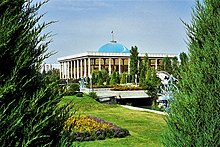
Tashkent has twinned cities with
-
 Istanbul , Turkey (1972)
Istanbul , Turkey (1972) -
 Berlin , Germany (1993)
Berlin , Germany (1993) -
 Dnipro , Ukraine (1998)
Dnipro , Ukraine (1998) -
 Kortrijk , Belgium
Kortrijk , Belgium
-
 Marrakech , Morocco
Marrakech , Morocco
-
 Patiala , India
Patiala , India
-
 Zaragoza , Spain
Zaragoza , Spain
-
 Seattle , United States (1973)
Seattle , United States (1973) -
 Shanghai , China (1994)
Shanghai , China (1994) -
 Skopje , North Macedonia
Skopje , North Macedonia
-
 Tripoli , Libya
Tripoli , Libya
-
 Tunis , Tunisia
Tunis , Tunisia
-
 Varna , Bulgaria
Varna , Bulgaria
Cityscape and landmarks
Since the city was rebuilt after the earthquake of April 26, 1966, Tashkent has been a green and water-rich city with many parks and fountains. In the center of the city, buildings of old Uzbek architecture have been preserved, such as the Ko'kaldosh Madrasa - and the Barak-Chan Madrasa from the 16th century.
One of the oldest copies of the Koran is kept in Tashkent .
Old town
The old town is located in the northwest of Tashkent and is the only place in the city where you can still enjoy a touch of the oriental flair.
The old town bazaar Chorsu Bazar is one of the largest bazaars in the city and offers the most original goods. Only here you can buy traditional handicrafts, such as B. folk musical instruments and day nurseries. But there are also tons of cheap Chinese imported goods to buy.
Traditional dishes are best enjoyed in the Chigatai, a district full of small restaurants in the courtyards of the buildings. Almost all typical Uzbek dishes are available here, such as shashlik and plov .
Neustadt and the surrounding area
Tashkent's new town is connected to the semicircular Amir Timur Park. In the center of the small park is the equestrian statue of Amir Timur, a Central Asian conqueror of the 14th century. Near the park is the Amir Timur Museum, which is entirely dedicated to the new leading figure of Uzbekistan.
Not too far away is the Navoiy Theater with its characteristic fountain in the shape of a cotton boll. The theater itself was built mostly by Japanese prisoners of war in the 1940s. The New Town is also home to the National History Museum, the Museum of Applied Arts, the State Art Hall and the Romanov Palace .
The Navoiy Recreation Park is located in the southwest of the city. It includes an artificial lake and rides.
In the very south of Tashkent is the Railway Museum with a variety of exhibits from the history of the railway. You can also see a German steam locomotive from the 1940s, which found its way to Central Asia as spoils of war.
The zoo is located in the east of Tashkent. This is a popular excursion destination, but when it comes to animal welfare, it does not always meet European expectations. Exotic animals such as camels, lions and tigers are shown, as well as wild and farm animal species native to Uzbekistan. There are also numerous species of birds and fish to see.
A little to the north of the new town is the Tashkent TV tower , which is also accessible to tourists and offers a view of the city. Next to it there is the Aquapark, a kind of fun pool, and the Japanese garden.
Also worth seeing is the Tashkent metro, whose stops are designed with different motifs.
Economy and Infrastructure
economy
According to government figures, around 34,500 companies in Tashkent generate more than 14% of GDP. 67% of the economic output come from trading and service companies. Large industrial companies include TAPOICH, Toshkent traktor zavod (tractor factory) and O'zkabel. There are also numerous joint venture companies.
traffic
Air traffic
Tashkent International Airport is located in the south of the city.
Rail transport
The Trans-Aral Railway from Orenburg and the Trans- Caspian Railway from Türkmenbaşy end at Tashkent station . The city is a hub in Central Asia's rail network. For long-distance traffic, a new south station was built in the southeast of the city.
There are connections to Kazakhstan , Tajikistan and Russia , but also to the other large cities of Uzbekistan such as Samarqand , Buxoro or Termiz . The Registon Express connects Tashkent and Samarqand in just under four hours and the Sharq Express takes a little over seven hours for the Tashkent-Samarqand-Buxoro route.
The tram opened its traffic in 1913 and with a length of over 130 km it was the most important inner-city means of transport. From 2010, the route network was gradually reduced, although the company had procured 20 new low-floor trams in 2006 . In March 2016, the mayor announced that the trams would be on and the traffic would switch to buses by the end of the year. Despite protests from citizens' initiatives and passengers, the network, which was around 90 km long at the beginning of 2016, was largely shut down within two months . At the end of April 2016, the network only consisted of line 17, which was the last to be closed on May 2, 2016. The city administration had most of the track systems removed within a few weeks.
The Tashkent Metro was built in 1977 and today comprises 3 lines with a length of 39 km. Tashkent was the first city in Central Asia with a metro.
Road traffic

The inner-city road network is mainly laid out in the form of large boulevards and in some cases is in great need of renovation. The newer streets mostly lead to the official residence of the Uzbek president, such as B. the earlier Prospectus Kosmonavt . These streets will be cordoned off twice a day to allow the President to travel freely. A ring road leads around the city area. The M39 runs through Tashkent from Termiz to the border with Kazakhstan, the A373 runs from Tashkent to the border with Kyrgyzstan in the Fergana Valley.
A trolleybus network existed from 1947 to 2010 . Diesel buses, mostly of the Mercedes-Benz Conecto type, were procured as replacements . They were financed by Deutsche Bank with the support of what was then DaimlerChrysler AG and gradually replaced Mercedes-Benz O 405 buses , which were purchased in 1993.
education
- Academy of Sciences of the Republic of Uzbekistan
- Tashkent State Technical University
- Tashkent University of Information Technology
- Westminster International University in Tashkent
- National University of Uzbekistan
- Tashkent State Economic University
- State Foreign Language University
- Tashkent Institute for Textile and Light Industry
- Tashkent Institute of Railway Engineers
Culture
theatre
Alisher Navoiy Opera and Ballet Theater
Museums
- Amir Temur Museum on the history of the Timurids
- State Museum of the History of the Peoples of Uzbekistan
- Museum of Applied Arts
- Tamara Xanum Museum
Sports
The football team of the record champions Paxtakor Tashkent plays its games in the 35,000-seat Paxtakor Central Stadium . The club Bunyodkor Tashkent , founded in 2005 and playing in the JAR Stadium, caused a sensation in 2008 when they signed Brazilian star Rivaldo . Lokomotiv Tashkent played in the second division after relegation in 2010 . The MHSK stadium is used by different teams.
Every year, the WTA Tashkent (Tashkent Open) is a women's tennis tournament. In September 2014 the World Wrestling Championships 2014 took place in Tashkent .
From 1971 to 1988, the city was home to the Binokor Tashkent ice hockey team .
sons and daughters of the town
See also
literature
- W. Barthold and CE Bosworth: Art. "Ta sh kent" in The Encyclopaedia of Islam. New Edition Vol. X, pp. 348a-351a.
- Ashirbek Muminov et al. a .: "Islamic education in Soviet and post-Soviet Uzbekistan" in Michael Kemper, Raoul Motika and Stefan Reichmuth (eds.): Islamic Education in the Soviet Union and Its Successor States . Routledge, London, 2010. pp. 223-279.
- Jeff Sahadeo: Russian colonial society in Tashkent, 1865-1923 . Indiana University Press, Bloomington 2007.
- Paul Stronski: Tashkent. Forging a Soviet city 1930-1966 . University of Pittsburgh Press, Pittsburgh 2010.
Web links
- City website (Uzbek, Russian, English)
- Museum of Decorative and Applied Arts (Uzbek, Russian, English)
Individual evidence
- ↑ J. N. Roy / B. B. Kumar, India and Central Asia: classical to contemporary periods , Concept Publishing Company, 2007, p. 15ff
- ↑ D. Sinor, The Uralic and Altaic Series (Vol 1-150) , Vol. 26, Routledge Shorton, p. 82
- ^ Barthold and Bosworth in: Encyclopaedia of Islam. New Edition. s. v. TASHKENT
- ↑ World Urbanization Prospects - Population Division - United Nations. Retrieved July 23, 2018 .
- ↑ a b c Cf. Muminov et al. a .: Islamic education in Uzbekistan . 2010, p. 250.
- ↑ a b c Cf. Muminov et al. a .: Islamic education in Uzbekistan . 2010, p. 247.
- ↑ See Muminov et al. a .: Islamic education in Uzbekistan . 2010, p. 248.
- ↑ See Muminov et al. a .: Islamic education in Uzbekistan . 2010, p. 249f.
- ↑ See Muminov et al. a .: Islamic education in Uzbekistan . 2010, pp. 252-254.
- ↑ Central Asian ITL on the GULAG website of Memorial Deutschland e. V.
- ↑ ANGREN-ITL on the GULAG website of Memorial Deutschland e. V.
- ↑ Erich Maschke (ed.): On the history of the German prisoners of war of the Second World War. Verlag Ernst and Werner Gieseking, Bielefeld 1962–1977.
- ↑ Stronski 2010, pp. 271ff
- ↑ The War in Afghanistan
- ↑ Stronski 2010, pp. 279f
- ↑ Government portal of Uzbekistan ( Memento of the original from June 25, 2013 in the Internet Archive ) Info: The archive link was inserted automatically and has not yet been checked. Please check the original and archive link according to the instructions and then remove this notice. (accessed on July 22, 2011)
- ^ Christian Lücker: Tabula rasa in Tashkent . In: Tram Magazin 8/2016, pp. 36–39.
- ↑ evobus.de - 300 Mercedes-Benz buses for Uzbekistan

